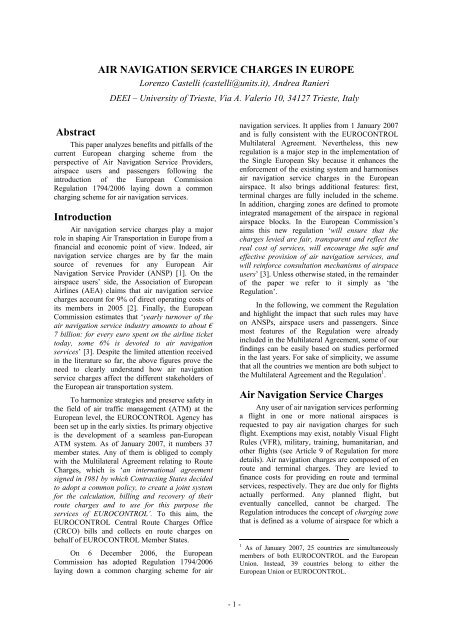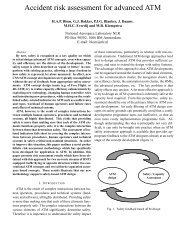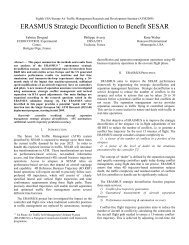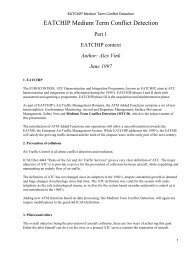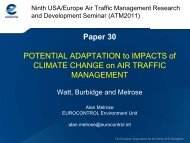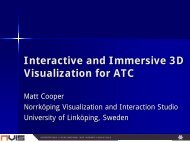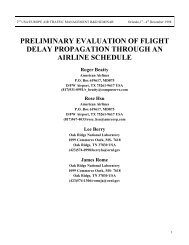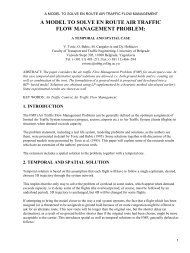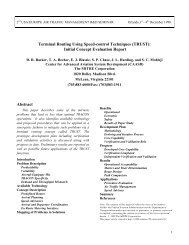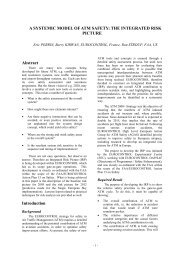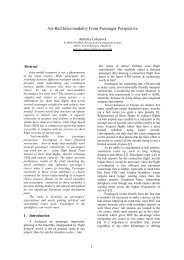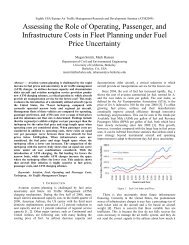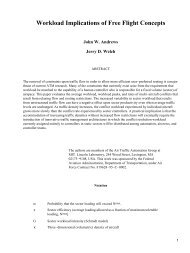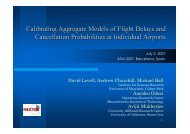Air Navigation Service Charges in Europe - ATM Seminar
Air Navigation Service Charges in Europe - ATM Seminar
Air Navigation Service Charges in Europe - ATM Seminar
Create successful ePaper yourself
Turn your PDF publications into a flip-book with our unique Google optimized e-Paper software.
doi: 10.4322/tmm.00202004
1. Non-discrim<strong>in</strong>ation based on the nationality ofthe airspace user. However, as underl<strong>in</strong>ed bythe Association of <strong>Europe</strong>an <strong>Air</strong>l<strong>in</strong>es (AEA) <strong>in</strong>different circumstances, some airl<strong>in</strong>es mayhave substantial benefits by the way ANSPsallocate their costs, e.g., if meteorological costsare levied to en route <strong>in</strong>stead of term<strong>in</strong>alcharges, carriers operat<strong>in</strong>g on that airport(homebased carriers) take clear advantage.2. Users are charged accord<strong>in</strong>g to their ability topay: the presence of the weight factor <strong>in</strong>to thecharg<strong>in</strong>g formula is <strong>in</strong> l<strong>in</strong>e with Ramseypric<strong>in</strong>g pr<strong>in</strong>ciples for the efficient recovery offixed costs and has been generallyacknowledged as a proxy for users’ ability topay [6]. Nevertheless, other studies affirm thata better proxy for the ability to pay would bethe seat<strong>in</strong>g capacity of an aircraft, which hasbeen proved to be related to the MTOW by afactor 0.7 [7].3. A unique charg<strong>in</strong>g system, i.e., the calculationof air navigation service charges follows thesame rules <strong>in</strong> (nearly) the whole <strong>Europe</strong>.4. Simplicity of the system of calculat<strong>in</strong>g en routecharges through a s<strong>in</strong>gle formula, and theircollection through a unique organization suchas EUROCONTROL CRCO.On the other side, the Regulation aims atgo<strong>in</strong>g over the ma<strong>in</strong> shortcom<strong>in</strong>gs of the previouscharg<strong>in</strong>g system.The <strong>Europe</strong>an Commission andEUROCONTROL [8] stated that the absence of<strong>in</strong>centives for both system users and providers tooptimize the use of exist<strong>in</strong>g capacity, or to respondto signal to <strong>in</strong>vest <strong>in</strong> new capacity, was one of thema<strong>in</strong> weaknesses of the previous charg<strong>in</strong>g system.Article 12 of the Regulation explicitly allowsMember States to establish or approve <strong>in</strong>centiveschemes […] to support improvements <strong>in</strong> theprovision of air navigation services […]. These<strong>in</strong>centives may apply to air navigation serviceproviders and/or airspace users. If the <strong>in</strong>centivescheme is limited <strong>in</strong> time, scope and amount, aMember State may modulate air navigation servicecharges, e.g., night-time charged differently fromdaylight-time, decreased charges accord<strong>in</strong>g toairborne equipment that <strong>in</strong>creases capacity or tooffsett<strong>in</strong>g the <strong>in</strong>convenience of choos<strong>in</strong>g lesscongested routes, […] to optimize the use of airnavigation services, to reduce the overall costs ofthese services and to <strong>in</strong>crease their efficiency.Nevertheless, the adoption of measures <strong>in</strong>centiv<strong>in</strong>gairspace users to avoid congested areas (spatialdifferentiation) or congested times (peakdifferentiation) may have limited impact on airl<strong>in</strong>esbehaviour. In fact, on one side there is evidence that<strong>in</strong> some circumstances en route charges are the costfactor driv<strong>in</strong>g airl<strong>in</strong>e operators to prefer longerroutes but cheaper <strong>in</strong> terms of en route charges [9].On the other side, we also showed [10] that trafficdemand is <strong>in</strong>elastic with respect to en route charges.In addition, most passengers travell<strong>in</strong>g dur<strong>in</strong>gcongested hours and areas are bus<strong>in</strong>ess customerswhose will<strong>in</strong>gness to pay is generally <strong>in</strong>sensitive toticket fares. Hence, airl<strong>in</strong>es might easilycompensate an <strong>in</strong>creased burden of air navigationservice charges through an appropriate ticketpric<strong>in</strong>g. However, some low cost and charterairl<strong>in</strong>es may operate flights at less congested timesand/or airspaces if peak pric<strong>in</strong>g would be<strong>in</strong>troduced.The lack of transparency <strong>in</strong> establish<strong>in</strong>g theannual forecasts for ANSPs’ cost bases and the lackof consultation with airspace users were othercauses of major concern of the previous charg<strong>in</strong>gsystem. Articles 8 and 15 of the Regulation dealwith both issues by ensur<strong>in</strong>g consultation withairspace users on the charg<strong>in</strong>g policy on a regularbasis and by grant<strong>in</strong>g to them the disclosure of thenecessary <strong>in</strong>formation on ANSP decisions on theircost bases, planned <strong>in</strong>vestments, expected trafficand charg<strong>in</strong>g mechanism. This transparency policyshould also enforce ANSPs to improve the controlof their costs thus provid<strong>in</strong>g further support to thealready exist<strong>in</strong>g trend of decreas<strong>in</strong>g en route unitcosts [11].F<strong>in</strong>ally, the obligation for ANSPs to <strong>in</strong>troduceterm<strong>in</strong>al charges will improve cost-reflectivity, i.e.,there will be better correlation between theoperational phases of control and types of chargeslevied.<strong>Air</strong> navigation service charges onairspace users<strong>Air</strong>space users (or aircraft operators) pay airnavigation service charges. S<strong>in</strong>ce the vast majorityof charged flights are performed by regular airl<strong>in</strong>esor carriers, <strong>in</strong> the rema<strong>in</strong>der of the paper weconsider airspace users (or aircraft operators) assynonymous of airl<strong>in</strong>es (or carriers), unlessotherwise specified. In this section, we analyse theimpact that air navigation service charges have onairl<strong>in</strong>e strategies and operations.Table 4 shows the air navigation servicecharges percentage of total operat<strong>in</strong>g costs for some<strong>Europe</strong>an airl<strong>in</strong>es, which published f<strong>in</strong>ancial resultsfor 2005, <strong>in</strong>clud<strong>in</strong>g en route charges amount voice.We observe that the impact of such unavoidablecharges significantly differs <strong>in</strong> accordance with theairl<strong>in</strong>e cost structure: low cost carriers (EasyJet andRyanair) are more affected than legacy carriersbecause of their simplified services offered topassengers thus reduc<strong>in</strong>g as much as possible their- 6 -
costs. As already mentioned <strong>in</strong> the <strong>in</strong>troduction, theAssociation of <strong>Europe</strong>an <strong>Air</strong>l<strong>in</strong>es (AEA) claimsthat air navigation service charges account for 9%of direct operat<strong>in</strong>g costs of its members <strong>in</strong> 2005.Similar f<strong>in</strong>d<strong>in</strong>gs are reported <strong>in</strong> [12]: air navigationservice charges represent from 2% to 6% of aircraftoperat<strong>in</strong>g costs, with the lower percentage appliedto long haul flights (possibly over oceans) and thehigher percentage related to regional flights thatoften face congestion and operational <strong>in</strong>efficiencyproblems.<strong>Air</strong>l<strong>in</strong>eAustrian<strong>Air</strong>l<strong>in</strong>esTotaloperat<strong>in</strong>g costsFY2005En routechargesamountShare2585,8 €m 126,6 €m 4,9%EasyJet 1132,5 £m 108,6 £m 9,6%Iberia 4823,2 €m 276,4 €m 5,7%Ryanair 1007,1 €m 135,7 €m 13,5%Table 4: Route <strong>Charges</strong> vs. total operat<strong>in</strong>g costsfor some companies<strong>Air</strong> navigation service charges on airl<strong>in</strong>estrategiesThe take-off of a specific aircraft at a giventime <strong>in</strong> a given airport is the outcome of a longplann<strong>in</strong>g process that may have started severalmonths before. The aim of such process, generallyreferred to as schedule plann<strong>in</strong>g, is to maximizeairl<strong>in</strong>e profitability [13]. Its ma<strong>in</strong> steps are theidentification of which Orig<strong>in</strong>-Dest<strong>in</strong>ation pairs toconnect, the frequency of departures and allocationto specific tim<strong>in</strong>gs based on market preferences, thetype and capacity of aircraft to be used, and thenumber of passengers to serve [14].In pr<strong>in</strong>ciple, the level of air navigation servicecharges may have an impact on such decisions.Nevertheless, long-term plann<strong>in</strong>g on which marketsto serve generally depends on macro-economicfactors as forecast of GDP, which is the ma<strong>in</strong> driverfor passenger growth, location and other marketfeatures. Other studies show that the number offlights and passenger demand are <strong>in</strong>elastic withrespect to en route charges [10].However, the fact that airl<strong>in</strong>es and passengershave such an <strong>in</strong>elastic attitude does not necessarilyimply that airl<strong>in</strong>es have to be <strong>in</strong>different tovariations to route charges. In fact, profit marg<strong>in</strong>smay be often very low, so even t<strong>in</strong>y percent costvariations may have a high impact on profits. Inparticular, even limited perturbations of en routecharges often have an impact on low-cost carriers,because such companies have already optimized theother components of the operat<strong>in</strong>g costs that aredirectly manageable.Hence the need to understand whether airl<strong>in</strong>eshave the opportunity to reduce the burden of airnavigation service charge on their balance sheets.<strong>Air</strong> navigation service charges on airl<strong>in</strong>eoperationsFollow<strong>in</strong>g airl<strong>in</strong>e cost classification <strong>in</strong> [14],air navigation service charges are direct variableoperat<strong>in</strong>g costs along with fuel and oilconsumption, airport fees, ma<strong>in</strong>tenance and crewcosts. More specifically, term<strong>in</strong>al charges dependon the schedule design and fleet assignment phaseswhere the departure and arrival aerodromestogether with the type of aircraft are decided. Sofar, term<strong>in</strong>al unit rates, when they exist, aregenerally the same for each aerodrome of a specificcountry. Hence, they have no impact on anyschedule design because their magnitude is too lowto <strong>in</strong>fluence airl<strong>in</strong>e’s decisions on which countriesto fly. However, <strong>in</strong> accordance with the Regulation,any ANSP may set different term<strong>in</strong>al unit rates fordifferent airports or groups of airports. It followsthat <strong>in</strong> the future term<strong>in</strong>al charges may become adriver, as airport fees are today, for airl<strong>in</strong>es to selectwhich airport to serve. There is also no evidencethat the limited level of term<strong>in</strong>al charges may haveany <strong>in</strong>fluence on airl<strong>in</strong>e decisions on which aircraftto use.On the other side, en route charges have<strong>in</strong>fluence on the airspace routes actually flown.Indeed, aircraft are not allowed to freely fly <strong>in</strong> the<strong>Europe</strong>an airspace, but are constra<strong>in</strong>ed to follow, atleast <strong>in</strong> pr<strong>in</strong>ciple, a sequence of ATC po<strong>in</strong>ts fromthe departure to the dest<strong>in</strong>ation aerodrome. Theflight level and the time each ATC po<strong>in</strong>t is crossed,along with other relevant <strong>in</strong>formation, are recorded<strong>in</strong> the Flight Plan that must be approved byEUROCONTROL Central Flow Management Unit(CFMU) before the aircraft actually takes off. Wedist<strong>in</strong>guish three phases: strategic (from severalmonths until two days before the flight), pre-tactical(two days before the day of operations) and tactical(<strong>in</strong> the day of the departure of the flight) plann<strong>in</strong>g.In the strategic plann<strong>in</strong>g phase aircraft operatorssubmit to CFMU flight plans represent<strong>in</strong>g – to thebest of their knowledge – their preferred routechoice for connect<strong>in</strong>g the specified departure anddest<strong>in</strong>ation aerodrome us<strong>in</strong>g the specified aircraft.In other words, any flight plan sent to CFMU <strong>in</strong> thestrategic phase <strong>in</strong>dicates the aircraft trajectory (both<strong>in</strong> the 3D space and <strong>in</strong> time) the airl<strong>in</strong>e would liketo follow <strong>in</strong> the actual day of flight operations. Inbuild<strong>in</strong>g such an “optimal” route, aircraft operatorsm<strong>in</strong>imise all the predictable costs associated to theflight: any unexpected event (like, e.g., weatherconditions or delays) that would possibly occur isnot taken <strong>in</strong>to account and is considered <strong>in</strong> the pretacticaland tactical phases.- 7 -
The factors produc<strong>in</strong>g predictable route costchanges when alternative routes are under<strong>in</strong>vestigation are fuel, en route charges,ma<strong>in</strong>tenance, and crew costs. Even though the routedesign process is also <strong>in</strong>fluenced by some otherfactors such as, e.g., mean delay <strong>in</strong> some airspace,frequency of restrictions <strong>in</strong> airspace, and quality ofservice obta<strong>in</strong>ed by ANSP, a few studies [9,15]show that en route charges have <strong>in</strong>fluence on theairl<strong>in</strong>e choice of the airspace route to be flownwhen connect<strong>in</strong>g a specific orig<strong>in</strong> and dest<strong>in</strong>ationpair. More precisely, due to the high variability ofen route unit rates among different countries, thereis evidence that <strong>in</strong> the strategic plann<strong>in</strong>g phaseairl<strong>in</strong>es, when alternatives exist, may prefer to flylonger routes (thus spend<strong>in</strong>g more <strong>in</strong> terms of fuel,ma<strong>in</strong>tenance and crew costs) but cheaper <strong>in</strong> termsof en route charges to m<strong>in</strong>imize their predictableroute costs. We claim that this is an undesirableeffect of the present system s<strong>in</strong>ce airl<strong>in</strong>e costs<strong>in</strong>crease due to higher fuel consumption, highercrew utilisation and ma<strong>in</strong>tenance costs. In addition,also pollution rises. Thus to some extent the presentroute charg<strong>in</strong>g scheme does not promote the bestuse of the available airspace because airl<strong>in</strong>es mayfly longer to mitigate the impact of en routecharges. There is also evidence that delays andregulations affect airl<strong>in</strong>es’ route choice. From atheoretical po<strong>in</strong>t of view, the <strong>in</strong>troduction of thecost of the delay reduces the <strong>in</strong>fluence that en routecharges may have on route choice. In [16] authorsgive an empirical proof of the weaker impact ofroute charges on airl<strong>in</strong>es’ behaviour when delays oren-route congestions occur.En route charges vs. fuel costsWe compare en route charges with fuel costsfor various categories of aircraft, as <strong>in</strong>dicated <strong>in</strong>Table 5.A380B747-400B757-200A319CRJ200MTOW (t) 560 395 113 68 24 12EMB120Weight Factor 3,35 2,81 1,50 1,17 0,69 0,49Fuel Cons. (Kl/h) 16,9 12,8 4,2 2,6 1,2 0,63Cruise speed (km/h) 1013 927 903 853 785 555Table 5: <strong>Air</strong>craft characteristics.The jet fuel price has been calculated us<strong>in</strong>gglobal average value calculated by IATA for theweek 12-19 January 2007 (Source:http://www.iata.org/whatwedo/economics/fuel_monitor/<strong>in</strong>dex.htm), correspond<strong>in</strong>g to 0,436 $/l,equivalent to 0,3373 €/l (accord<strong>in</strong>g to Euroexchange rate as at 18 th January 2007, published by<strong>Europe</strong>an Central Bank). Nevertheless, this price is<strong>in</strong>dicative as airl<strong>in</strong>es negotiate their own fuel pricesthat largely vary from place to place and fromairl<strong>in</strong>e to airl<strong>in</strong>e. In addition, this price does notexactly track the price of a barrel of oil because fuelis generally bought <strong>in</strong> advance on the futuresmarket <strong>in</strong> a process called hedg<strong>in</strong>g.A380B747 -400B757 -200A319CRJ200EMB120Fuel Cost 5,63 4,66 1,57 1,03 0,52 0,38Table 6: Fuel Cost per km (€/km).Figure 4 shows the ratio obta<strong>in</strong>ed by divid<strong>in</strong>gen route charge cost per km by fuel cost per km(Table 6), for different values of en route unit rates.Ratio2,521,510,5EMB120CRJ200A319B757-200B747-400A38000 25 50 75 100En Route Unit RateFigure 4: En route charge Cost/Fuel Cost perkm per aircraft type.Consider<strong>in</strong>g the average unit rate <strong>in</strong> 2007equal to 51,52 € (Table 2), we claim that for smallaircraft en route charges have almost the samemagnitude per km as fuel costs, while for largeraircraft en route charges should almost doublebefore be<strong>in</strong>g equal to fuel costs. This resultdemonstrates that the cost of en route route chargesis not <strong>in</strong>significant, expecially for small aircrafts.<strong>Air</strong> navigation service charges onpassengersS<strong>in</strong>ce air navigation service charges representa non-negligible fraction of variable directoperat<strong>in</strong>g costs of airl<strong>in</strong>es, they are also likely toaffect passenger ticket price. Unfortunately, it is notstraightforward to estimate such impact becausethey are not charged directly to passengers by anytaxes and fees, as airport fees or fuel surcharges,but are implicitly <strong>in</strong>cluded <strong>in</strong> the base fare ticket.This is a major difference with the U.S., where thefederal ticket (7.5% of the base fare ticket price)- 8 -
AppendixICAOCodeCountryICAOCodeCountryEB Belgium LM MaltaED Germany LI ItalyLF France LC CyprusEG United K<strong>in</strong>gdom LH HungaryEH Netherlands EN NorwayEI Ireland EK DenmarkLS Switzerland LJ SloveniaLP Portugal LR RomaniaLO Austria LK Czech RepublicLE Cont<strong>in</strong>ental Spa<strong>in</strong> ES SwedenGC Canary Islands LZ SlovakiaAZ Portugal Santa Maria LD CroatiaLG Greece LB BulgariaLT Turkey LW MacedoniaTable A. ICAO Country CodesReferences[1] EUROCONTROL PRU, June 2006, <strong>ATM</strong> CostEffectiveness 2004 Benchmark<strong>in</strong>g Report.[2] Association of <strong>Europe</strong>an <strong>Air</strong>l<strong>in</strong>es, December2006, Summary Report.[3] <strong>Europe</strong>an Commission Press ReleaseIP/06/1693[4] EUROCONTROL PRC, April 2006,Complexity Metrics for ANSP Benchmark<strong>in</strong>gAnalysis.[5] Steer Davis Gleave, 2004, Study on thef<strong>in</strong>anc<strong>in</strong>g of air traffic management to achieve theS<strong>in</strong>gle <strong>Europe</strong>an Sky, S<strong>in</strong>gle Sky F<strong>in</strong>al Report.[6] Raffar<strong>in</strong>, Marianne, 2004, Congestion <strong>in</strong><strong>Europe</strong>an <strong>Air</strong>space. A pric<strong>in</strong>g solution? Journal ofTransport Economics and Policy, 38, 109-126.[7] PriceWaterhouseCoopers, 2001, Study of theTerm<strong>in</strong>al <strong>Charges</strong> for <strong>Air</strong> Traffic Control <strong>Service</strong>s.[8] EUROCONTROL PRC, 2005, An Assessmentof <strong>Air</strong> Traffic Management <strong>in</strong> <strong>Europe</strong> dur<strong>in</strong>g theCalendar Year 2004.[9] Castelli, Lorenzo, Raffaele Pesenti, WalterUkovich, 2004, Analysis of <strong>Air</strong>l<strong>in</strong>e OperationalBehaviours, F<strong>in</strong>al Report of WorkPackage 4 ofEUROCONTROL Care Innovative Project‘Innovative Route Charg<strong>in</strong>g Schemes’.[10] Castelli, Lorenzo, Raffaele Pesenti, WalterUkovich, 2003, Study of ATS demand elasticity ofairspace users, F<strong>in</strong>al Report of WorkPackage 5 ofEUROCONTROL Care Innovative Project‘Innovative Route Charg<strong>in</strong>g Schemes’.[11] EUROCONTROL PRC, 2006, An assessmentof <strong>Air</strong> Traffic Management <strong>in</strong> <strong>Europe</strong> dur<strong>in</strong>g thecalendar year 2005.[12] Swan, William M., Nicole Adler, 2006,<strong>Air</strong>craft trip cost parameters: A function of stagelength and seat capacity, Transportation ResearchPart E, 42(2), 105-115.[13] Barnhart, Cynthia, Peter Belobaba, Amedeo R.Odoni, 2003, Applications of Operations Research<strong>in</strong> the <strong>Air</strong> Transport Industry, TransportationScience, 37(4), 368-391.[14] Holloway, Stephen, 2003, Straight and Level:Practical <strong>Air</strong>l<strong>in</strong>e Economics, Ashgate Publish<strong>in</strong>gLimited, Hampshire, England.[15] Babić, Obrad, Voj<strong>in</strong> Tošić, 2005, Serbia andMontenegro <strong>Air</strong> Traffic Analysis and Forecast,Internal report, Faculty of Transport and TrafficEng<strong>in</strong>eer<strong>in</strong>g, University of Belgrade, Serbia.[16] Brunetta, Lorenzo, Luca Righi, GiovanniAndreatta, 2004, Analysis of alternative routes forselected city pairs, F<strong>in</strong>al Report of WorkPackage 6Part II of EUROCONTROL Care InnovativeProject ‘Innovative Route Charg<strong>in</strong>g Schemes’.[17] Yamanaka, Shiro, Joakim Karlsson, AmedeoR. Odoni, November 2005, Aviation <strong>in</strong>frastructuretaxes and fees <strong>in</strong> the United States and the<strong>Europe</strong>an Union, Compendium of Papers CD-ROM, 85th Annual Meet<strong>in</strong>g of the TransportationResearch Board, Wash<strong>in</strong>gton, DC.[18] EUROCONTROL PRC, May 2003, Acomparison of performances <strong>in</strong> selected US and<strong>Europe</strong>an En-route centres.[19] Castelli Lorenzo, Philippe Debels, WalterUkovich, 2005, Route-charg<strong>in</strong>g policies for acentral <strong>Europe</strong>an cross-border upper airspace,Journal of <strong>Air</strong> Transport Management, 11, 432-441.Keywords<strong>Air</strong> navigation charges, air trafficmanagement, economic analysis.BiographiesLorenzo Castelli is currently Assistant Professor <strong>in</strong>Operations Research at the University of Trieste,Italy. He holds a Ph.D. <strong>in</strong> Transportation.Andrea Ranieri is a Ph.D. student at the Universityof Trieste, Italy. He developed his Master thesis atEUROCONTROL CRDS <strong>in</strong> Budapest, Hungary.- 10 -


